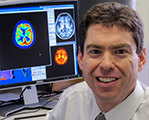Amyloid Imaging: A “Game Changer” in the Diagnosis of Alzheimer’s Disease
The following was written by Gil Rabinovici, MD, Assistant Professor of Neurology at the UCSF Memory and Aging Center.
The diagnosis of Alzheimer’s disease (AD) is currently made on clinical grounds, with laboratory tests and brain imaging – CT or MRI – performed primarily to exclude other causes of cognitive decline (e.g. vitamin and hormone deficiencies, strokes, brain infections, etc.). However, even when established by experts, the clinical diagnosis of AD during life is accurate only 70 – 80 percent of the time when compared to brain autopsy findings. One of the major recent advances in brain imaging is the development of PET tracers that bind to amyloid plaques, a core pathologic feature of the disease. The ability to directly detect amyloid during life (as opposed to during autopsy after death) is a potential “game changer” in establishing the early and accurate diagnosis of AD. Studies suggest that amyloid PET scans during life have greater than 90 percent accuracy in detecting amyloid plaques, when compared to tissue analysis after death.
Amyloid imaging has been used extensively in research studies of AD and aging since 2004. In April 2012, the U.S. Food and Drug Administration approved the use of the amyloid PET tracer AmyvidTM (florbetapir) for clinical use. Despite FDA approval, amyloid PET has been slow to translate into clinical practice for a number of reasons. First, interpreting the clinical significance of am imaging scan is not straightforward. Amyloid deposits can be found in the brain in disease other than AD (e.g. Lewy body dementia, amyloid angiopathy) and in 20 – 30 percent of cognitively normal older individuals. Given these caveats, amyloid scans should only be ordered and interpreted by physicians who are experienced in the evaluation of cognitive disorders and are familiar with the nuances of the technology. Second, amyloid scans are not currently reimbursed by Medicare or most other third party payers. In recently deliberating coverage, the Centers for Medicare and Medicaid Services (CMS) concluded that more evidence is needed to establish whether and how amyloid PET impacts patient diagnosis, treatment, and other clinical outcomes.
Since the earliest days of this technology, UCSF has been at the forefront of amyloid imaging research. The UCSF-based Alzheimer’s Disease Neuroimaging Initiative (ADNI) is a large, multi-site study applying amyloid imaging and other imaging modalities and biological markers to study the natural history of AD, with the goal of utilizing imaging and other disease markers to measure the efficacy of new treatments. Investigators at the UCSF Memory & Aging Center are studying the utility of amyloid imaging in differentiating AD from other causes of cognitive decline such as frontotemporal dementia. Clinical amyloid PET scans are also available for patients meeting appropriate criteria through the UCSF Dept. of Radiology.
Even as the field is in the process of defining the optimal clinical and research applications of amyloid imaging, new PET tracers have been developed that image the tau protein that forms neurofibrillary tangles, the other core pathologic lesion in AD. Research studies of Tau PET will commence at UCSF in late 2013-early 2014. Our great hope is that these amazing advances in diagnostics will lead to breakthroughs in treatment, enabling early intervention with drugs that target the specific proteins depositing in the brain and leading to cognitive dysfunction. Stay tuned for new developments in this rapidly evolving field!
Join the conversation below!

